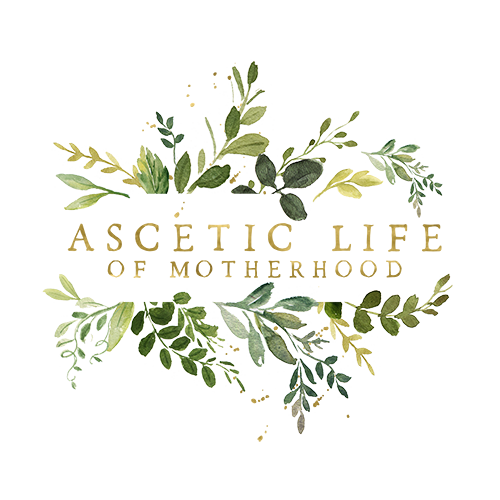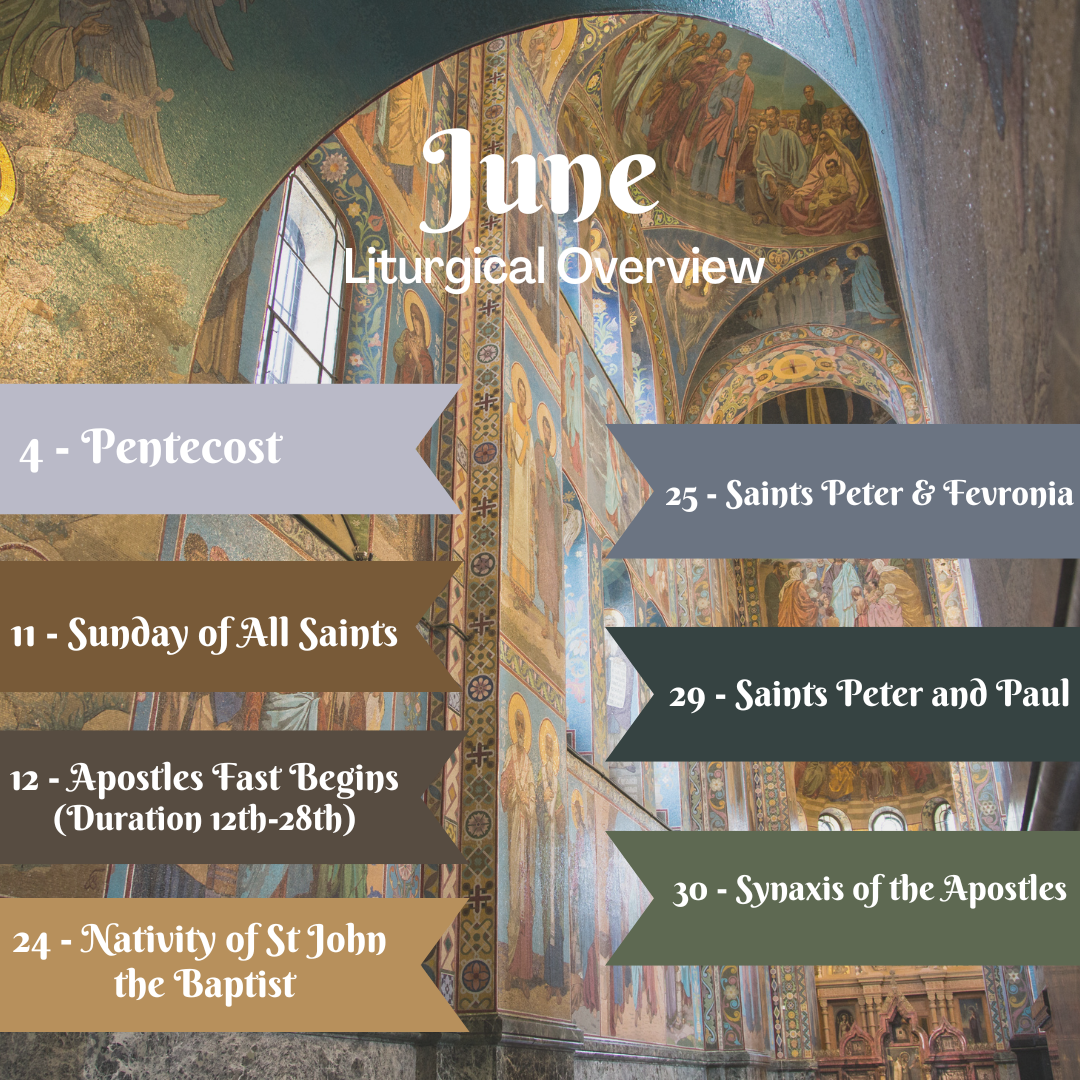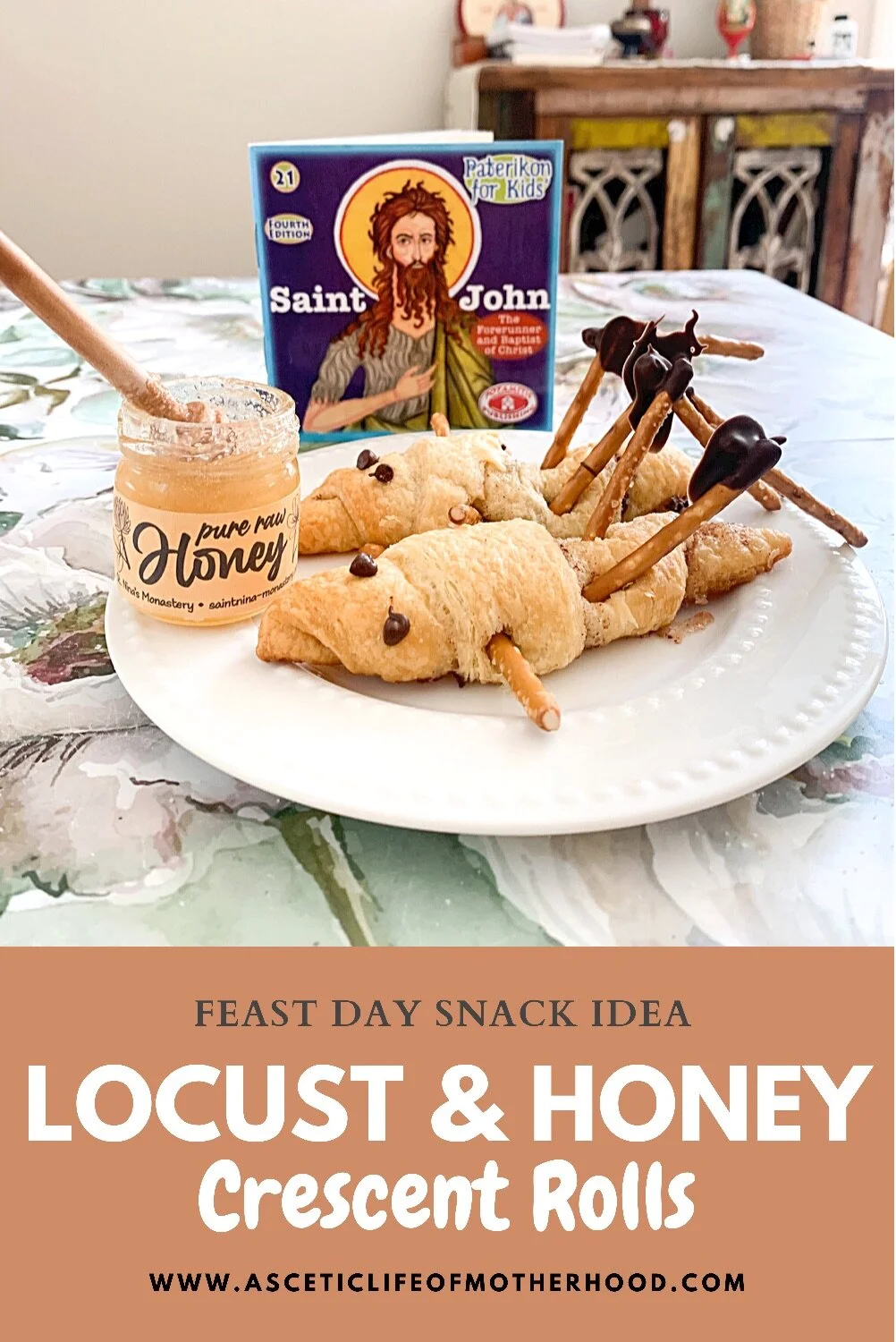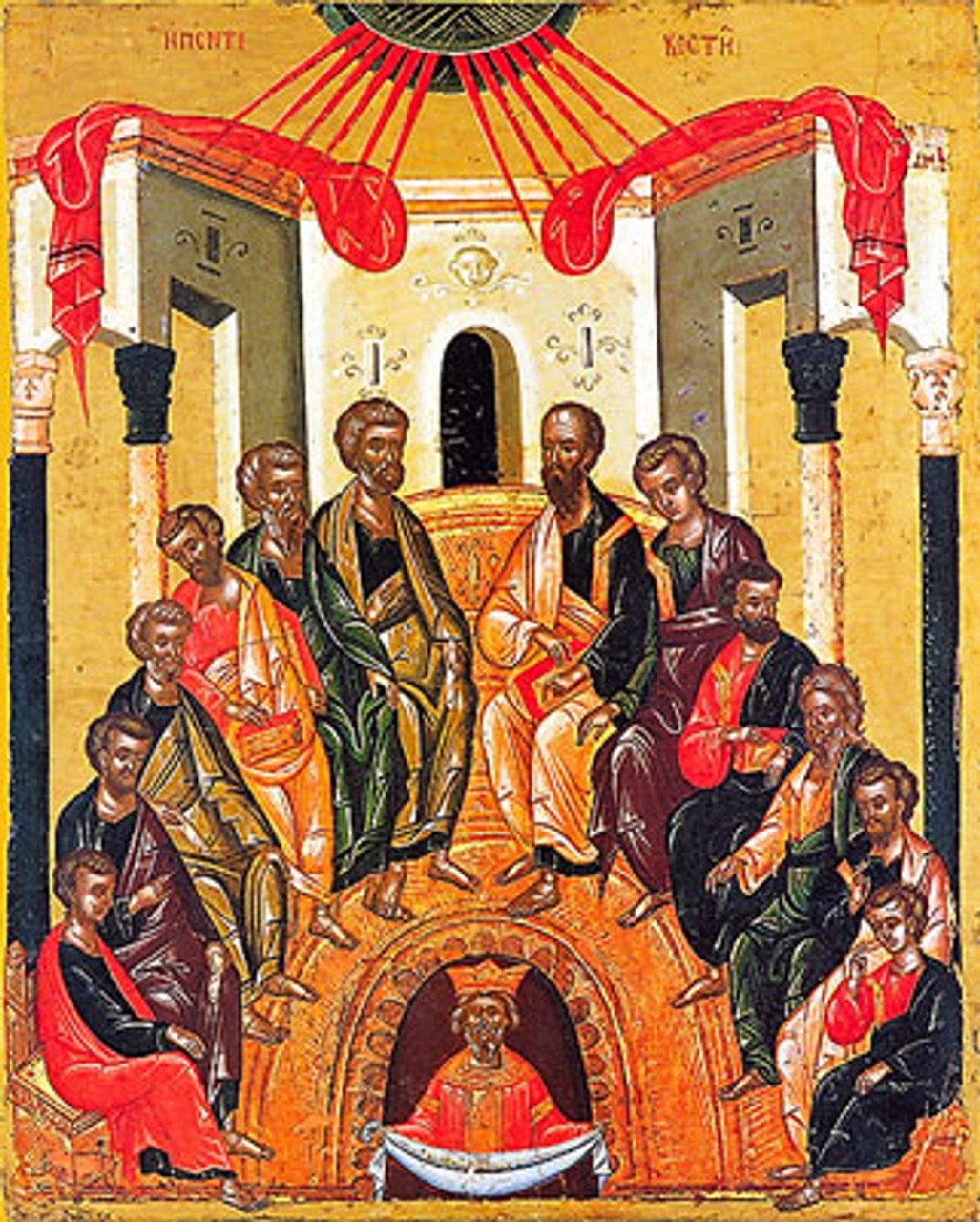June Liturgical Overview
I wanted to create an overview of the various Feast Days or special Liturgical Days coming up this month. As a parent, I know what a difficult task it can be to stay ahead of the Liturgical calendar, particularly during a busy season like this one, so I hope to help other parents by providing timely reminders and age appropriate resources to help share the Faith with their children. I want to provide ways to more easily engage/connect our Liturgical lives, not only with our participation in the life of the church, but in our homes as well. In this guide you will find an overview of each day mentioned above, and some fun ways to participate using what you have at home, or what you can easily gather or print, book recommendations, and I’ve included links to additional resources I’ve found. I pray that together we can raise up the next generation of Christians who love God with all their hearts and minds!
Scroll down to see resources for the main Feast Days celebrated in June!
OR Check out these Individual Blogposts:
Pentecost
Celebrated June 4th, 2023
Pentecost Icon available for Purchase through Uncut Mountain Supply Co
The Feast of Holy Pentecost is celebrated each year on the 50th day after Pascha and 10 days after the Feast of the Ascension of Christ. The Feast is always celebrated on a Sunday and is one of the 12 Great Feasts in the Orthodox Church. The story of Pentecost is found in the book of Acts. In Chapter 2, we are told that the Apostles were gathered together in one place and suddenly, a sound came from heaven like a rushing wind, filling the entire house where they were sitting. Then, tongues of fire appeared, and one sat upon each one of Apostles. They were all filled with the Holy Spirit and began to speak in other languages as directed by the Spirit (Acts 2:1-4). This caused such a disturbance that others in Jerusalem heard and drew near in shock as they listened to the disciples speaking in their own language. Many believed, and they asked the Apostles, "What shall we do?" and Peter said to them, "Repent, and let every one of you be baptized in the name of Jesus Christ for the remission of sins; and you shall receive the gift of the Holy Spirit" (Acts 2:38-39). The Bible records that on that day about 3000 were baptized. The book of Acts states that the newly baptized continued daily to hear the teaching of the Apostles, as the early Christians met together for fellowship, the breaking of bread, and for prayer. Many wonderful signs and miracles were done through the Apostles, and the Lord added to the Church daily those who were being saved (Acts 2:42-47).
Old Testament Connection - Did you know that Pentecost was the feast celebrated in the Old Testament? Acts chapter 2 mentions the disciples were gathered together on the “Day of Pentecost”. The feast of Pentecost in the Old Testament was given because God commanded the Jews in Leviticus 23:15-16, to count seven full weeks (or 49 days) beginning on the second day of Passover, and then present offerings to the Lord. It is also believed that this was the day that Moses received the 10 commandments by God on Mt Sinai. But wait, there’s more! Jesus was crucified on Passover: God offers Himself as a sacrifice for his people, and 50 days later we have Pentecost - when the Holy Spirit descends. It’s really eye opening to see these connections between the Old Testament and the New Testament. Sometimes these connections make me sit in awe realizing everything has meaning.
I want to leave with you a quote that summarizes this connection well:
“. . . For as of old on the fiftieth day after the Sacrifice of the Lamb, the Law was given on Mount Sinai to the Hebrew people, now delivered from the Egyptians, so, after the Passion of Christ, in which the True Lamb of God was slain, on the fiftieth day after His Resurrection, the Holy Spirit descended upon the Apostles and upon the people who believed (Acts 2:3); so that an earnest Christian might know beyond any uncertainty, that the sacred rites of the Old Testament had served as foundations for the Gospel, and that by this same Spirit was the Second Covenant laid down, by Whom the first had been established.”
+ St. Leo the Great
Holy Spirit Day - On the Monday following the Feast, the Divine Liturgy is celebrated in commemoration of the Holy Spirit: The All-holy and Life-creating and All-powerful Spirit, Who is God, and One of the Trinity, and of one honor and one essence and one glory with the Father and the Son (From the Synaxarion of the Feast).
Fun Fact - On this day, we resume a few practices that have been suspended since Pascha: KNEELING : We resume the practice of kneeling during the Liturgy at the time when the holy gifts of bread and wine are consecrated as the body and blood of Christ. The practice of kneeling has been suspended during the Paschal season and is reintroduced again after the Divine Liturgy. O HEAVENLY KING : From Pascha until Pentecost, the prayer “O Heavenly King,” where we invoke the presence of the Holy Spirit, is not said either in Church or in our private prayers at home. The removal of this familiar prayer from the cycle of the services emphasizes the importance of the descent of the Holy Spirit that we celebrate at Holy Pentecost. “O Heavenly King” will be heard again at the Aposticha of the Festal Great Vespers for Pentecost and returned to our services and prayers.
You might be interested in:
Check out 10 Ways to Celebrate Pentecost blogpost for tons of and easy ideas!
Activity Ideas :
Attend Divine Liturgy - As I often say, the best way to celebrate a feast day is by attending a Divine Liturgy. This is an important way to connect our lives at home with our lives in the church. Check with your local Church to see when the service is being offered.
Lesson Plan and Paper Puppets by Orthodox Pebbles - Once again, Orthodox Pebbles knocks it out of the park with their lesson on Pentecost! In this lesson you will find an icon worksheet, a cut-and-glue-craft, worksheets to help with the details of the story, and activities, which you can find through this link HERE.
*If you enjoy these materials, please consider making a donation in support of the hard working Orthodox moms behind these incredible materials or become a Patreon
Edible "‘Tongues of Fire" Snack Ideas :
Flame Cupcakes - Make cupcakes (any flavor will do) and decorate using yellow frosting on top and add slices of strawberries on the top resembling a little flame. RECIPE HERE
Flame Stawberry and Banana - This simple snack can be pulled together in just a few seconds. You can even make a bunch of them and form them in a half circle, resembling the tongues of fire on the Apostles’ heads in the icon.
Tongues of Fire Cupcakes
Flame Strawberry and Banana Snack
Listen to Podcast Readings from Under the Grapevine which includes 2 Stories on Pentecost
Say a prayer to the Holy Spirit as a family: ‘O heavenly King, the Comforter, Spirit of Truth, Who art in all places, and fillest all things, Treasury of good things, and Giver of life, come, and dwell in us, and cleanse us from every stain; and save our souls, O good One.’
Wear Green to Liturgy! The liturgical color of Pentecost is green. You can dress your family in green to help your children notice this change in the church! Green is the symbol for life, so in the green we can see a connection to themes of “life-giving”: the Holy Spirit which descends on Pentecost brings life into us!
Coloring Page for Pentecost from OCA (Scroll to Bottom of Page)
Sing Along with Gigi Baba in her song “Birthday of the Church (Pentecost)" On YouTube
Book Recommendations :
The Feast of Pentecost The Feast of Pentecost from by Mother Melania
Heaven Meets Earth: Celebrating Pascha and the Twelve Great Feasts by Ancient Faith Publishing
The Great Feasts by Exaltation Press
For Biblical Stories, we love to read them directly from the source! Read the story of Pentecost in Acts 2:1–31.
Sunday of All Saints
Celebrated June 11th, 2023
Sunday of All Saints - the Sunday following Pentecost is dedicated to All Saints, both those who are known to us, and those who are known only to God. There have always been saints, and they have come from every corner of the earth. They were Apostles, Martyrs, Prophets, Hierarchs, Monastics, and Righteous, and all were perfected by the same Holy Spirit. By the descent of the Holy Spirit, it is possible for us to rise above our fallen state and to attain sainthood, fulfilling God’s directive to “be holy, for I am holy” (Lev. 11:44, 1 Peter 1:16). So, it is fitting to commemorate All Saints on the first Sunday after Pentecost. Guided by the teaching of the Divine Scriptures and Apostolic Tradition, we honor all the Saints, the friends of God, for they are keepers of God's commandments, shining examples of virtue. Of course, we honor the known Saints especially on their own day of the year. But since many Saints are unknown, and their number has increased with time, and will continue to increase until the end of time, the Church has appointed that once a year a common commemoration be made of all the Saints the Sunday following Pentecost.
“Therefore, since we are surrounded by such a great cloud of witnesses, let us throw off everything that hinders and the sin that so easily entangles. And let us run with perseverance the race marked out for us, fixing our eyes on Jesus”
Saints in the Scriptures - In Hebrews chapter 11-12, St Paul tells a beautiful story of the Righteous who have gone before us, Saints since the beginning of time, starting with Abel and includes the many righteous decendents of Christ, “And what more shall I say? I do not have time to tell about Gideon, Barak, Samson and Jephthah, about David and Samuel and the prophets, who through faith conquered kingdoms, administered justice, and gained what was promised; who shut the mouths of lions, quenched the fury of the flames, and escaped the edge of the sword; whose weakness was turned to strength; and who became powerful in battle and routed foreign armies. Women received back their dead, raised to life again. There were others who were tortured, refusing to be released so that they might gain an even better resurrection. Some faced jeers and flogging, and even chains and imprisonment. They were put to death by stoning; they were sawed in two; they were killed by the sword. They went about in sheepskins and goatskins, destitute, persecuted and mistreated— the world was not worthy of them. They wandered in deserts and mountains, living in caves and in holes in the ground. These were all commended for their faith, yet none of them received what had been promised, since God had planned something better for us so that only together with us would they be made perfect.”
Icon of the Sunday of All Saints - The icon of the Sunday of All Saints depicts our Lord and Savior Jesus Christ seated above the throne of heaven surrounded by the Saints. The rows of Saints included the Archangel Michael and other Angels, the Theotokos and John the Baptist, the Apostles, Bishops, Great Martyrs, Ascetics and Monastics. To the side of the throne are Adam and Eve, bowing in reverence to Christ. They are joined by the Saints, who are lifting their hands in worship to the King of Glory. At the lower left of the icon is the Patriarch Abraham who has a righteous soul in his bosom, as told in the story of Lazarus and the rich man in the Gospel. At the lower center is the Good Thief who was crucified with Christ. On the lower right is the Patriarch Jacob.
You might be interested in:
Check out this blogpost for ideas to celebrate All Saints Day!
Activity Ideas :
Have Your Children Dress as Their Favorite Saint - This is a super fun way to teach your children about the Saints. Challenge yourself to make an outfit from what you have on hand, it’s just more fun that way! This year my kids dressed up as their patron saints (St Elizabeth the New Martyr, St Adelaide of Rome, and St Daniel the Prophet). Check out our DIY Costumes in this blogpost! You can also find additional costume ideas Pinterest !
Throw an All Saints’ Day Party - I look for any excuse to have a party, and certainly a Feast Day celebrating All Saints is a perfect excuse! Have your guests dress up as their favorite Saint, serve special foods like “Angel Food Cake”, pray together, and feast with one another!
Saintly Halos using a can of Pineapple Rings which can be purchased at any grocery store!
Symbolic Snack Ideas:
Saintly Halos - want a simple symbolic way to remember the saints? Buy and serve a can of sliced pineapple rings and serve to your kids as a snack. They remind us of the halos of uncreated light around the saints!
Buy or make Donuts - it may be a bit of a stretch, but why not serve donuts with a hole in the middle as a symbolic food! The circle of the donut reminds of the halo of uncreated light and the hole symbolizes the “holiness” of the saints!
Serve the poor, sick, suffering, and lonely - I can’t think of a better way to honor the Saints than to serve the needy in their honor. Each and every Saint was a human just like me and you. Jesus says “Truly, I say to you, as you did it to one of the least of these my brothers, you did it to me.” (Matt 25:26) Some ideas include: volunteer at a food bank, bring donuts to shut-ins, care for the sick, write a card to someone far away.
Ask for the Saints to Pray for us - What is this great feast day all about? The gift of our friends in heaven who pray and help us. Ask for the intercessions from your favorite saints! St John Chrysostom says "We should seek the intercessions and the fervent prayers of the saints, because they have special 'boldness', before God."
Book Recommendations :
101 Orthodox Saints by Ancient Faith Publishing
Read a Saint Story (or two!) - My favorite way to teach anything (especially the faith) is through stories. You can read the lives of the Saints in the Synaxarion is a compilation of the lives of the saints. Patristic Nectar Publications has recorded hundreds of stories which you can listen to and access HERE.
My Synaxarion “A Saint for Every Day” by Potamitis Publishing - is a brand new series of books, with each book covering the Saints' lives commemorated each month. Currently January and September are available!
The Apostles Fast
Duration: June 12 - June 28 (Old Calendar June 12 to July 12)
Apostles Fast - is just one of the four Fasting Periods in the Orthodox Church. The Church, in her wisdom, offers us the period of the Apostles’ Fast soon after Pentecost and just prior to the feast of the Holy Apostles Peter and Paul, who were worthy to receive the Holy Spirit. The Apostles’ Fast is a prescribed fasting period of the Church, lasting from the day after the Sunday of All Saints until the feast of the Apostles Peter and Paul (June 29th). This Sunday is always one week after the Sunday of Pentecost, so the length of the Apostles' Fast varies from year to year depending on the date of Pascha. The fast of the Holy Apostles is very ancient, dating back to the first centuries of Christianity. We have the testimony of St. Athanasius the Great, St. Ambrose of Milan, St. Leo the Great and Theodoret of Cyrus regarding it. The oldest testimony regarding the Apostles’ Fast is given to us by St. Athanasius the Great (373 AD). If the aim of the Christian life is to aquire the Holy Spirit, we too must engage in the struggle through fasting and continual prayer. It is only then that we may acquire the Holy Spirit and can properly appreciate and be joyous in the feast of the Holy Apostles Peter and Paul.
“Can you make the friends of the bridegroom fast while he is with them? But the time will come when the bridegroom will be taken from them; in those days they will fast.”
Why does the Apostles Fast vary in length?
Here is an interesting fact about the Fast: it doesn’t have a set date and its length varies from year to year. Why is that the case? Although there is evidence that this fast was well in circulation in the liturgical cycle before this date, the Orthodox Apostles Fast was officially established during the Ecumenical Council of Nicea in 325 AD. It was decided that the Fast must start on the second Monday after the Feast of Pentecost (or the next day after the Feast of All Saints) and continue right until the day when we commemorate Saints Peter and Paul. This is why it is often called the Peter and Paul Fast. This means that its length is not set, but determined by the day of Pascha. For example, in 2023 the Apostles Fast will last for just over 2 weeks, whereas in 2021 it only lasted 1 day!
What are the general fasting rules for the Apostles Fast?
The guidelines below are general. Fasting is a spiritual discipline that should be practiced with the oversight and direction of your spiritual father. If you have any specific questions about how the fasting discipline applies to you or your family, you should consult your spiritual father. The general guidelines for the Apostles’ Fast are as follows:
MONDAYS, WEDNESDAYS, and FRIDAYS are Strict Fast Days. On these days we abstain from meat, dairy, fish with backbones, fowl, wine, and oil.
TUESDAYS and THURSDAYS are Wine and Oil Days. On these days the fast is relaxed to permit wine and oil, but we still abstain from meat, dairy, fish with backbones, and fowl.
SATURDAYS and SUNDAYS are Fish, Wine, and Oil Days. On these days the fast is further relaxed to permit fish with backbones in addition to wine and oil, but we still abstain from meat, dairy, and fowl.
Fasting Resources:
Parousia Press has a wonderful collection of resources for fasting which you can find here
Stay Tuned for our Apostles Fast Meal Planner - Coming Soon!
Nativity of St John the Baptist
Celebrated June 24th, 2023
Nativity of St John the Baptist - St. John was the son of the Prophet Zacharias and Elizabeth, who was the cousin of the Mary, the mother of Jesus (Theotokos). St. John is known as the “Forerunner” and “Baptist.” He is known as the Forerunner because he preceded Christ and taught repentance, which prepared men for Jesus’ teaching and His ministry. He even recognized Christ as the Messiah as early as when they were both still in their mothers’ wombs. The scriptures tell us the story of the miraculous birth of St John the Baptist in Luke 1. His parents, St Elizabeth and Priest Zachariah, were described as righteous before God, observing all the Lord’s commands and decrees blamelessly. But they were baren and childless because Elizabeth was not able to conceive, and they were both very old.
An angel of the Lord appeared to Zachariah, and he was startled and gripped with fear. But the angel said to him: “Do not be afraid, Zechariah; your prayer has been heard. Your wife Elizabeth will bear you a son, and you are to call him John. He will be a joy and delight to you, and many will rejoice because of his birth, for he will be great in the sight of the Lord. He is never to drink wine or other fermented drink, and he will be filled with the Holy Spirit even before he is born. He will bring back many of the people of Israel to the Lord their God. And he will go on before the Lord, in the spirit and power of Elijah, to turn the hearts of the parents to their children and the disobedient to the wisdom of the righteous—to make ready a people prepared for the Lord.” (Luke 1:11-17) Zechariah questions the angel doubting how this would be possible seeing as his wife was very old. The angel said to him, “I am Gabriel. I stand in the presence of God, and I have been sent to speak to you and to tell you this good news. And now you will be silent and not able to speak until the day this happens, because you did not believe my words, which will come true at their appointed time.” He returned home, unable to speak. Elizabeth became pregnant and for five months remained in seclusion. It was in the 6th month of her pregnancy that we see that Mary is also visited by the same Archangel Gabriel with the news that she too will conceive a child.
Mary visits Elizabeth and when Elizabeth heard Mary’s greeting, the baby leaped in her womb, and Elizabeth was filled with the Holy Spirit. In a loud voice she exclaimed: “Blessed are you among women, and blessed is the child you will bear! But why am I so favored, that the mother of my Lord should come to me? As soon as the sound of your greeting reached my ears, the baby in my womb leaped for joy. Blessed is she who has believed that the Lord would fulfill his promises to her!” (Luke 1:39-45). According to Holy Tradition, the baby leaping in his mother’s womb is considered his first acknowledgment of Christ as Messiah.
When it was time for Elizabeth to have her baby, she gave birth to a son. On the eighth day they came to circumcise the child, and they were going to name him after his father Zechariah, but his mother spoke up and said, “No! He is to be called John.” They said to her, “There is no one among your relatives who has that name.” Then they made signs to his father, to find out what he would like to name the child. He asked for a writing tablet, and to everyone’s astonishment he wrote, “His name is John.” Immediately his mouth was opened and his tongue set free, and he began to speak, praising God. And the child grew and became strong in spirit; and he lived in the wilderness until he appeared publicly to Israel.
Interesting Fact: According to Tradition, after the Nativity of Jesus and the worship of the shepherds and the Magi, wicked king Herod gave orders to kill all male infants. Hearing about this, St Elizabeth, St John’s mother, fled into the wilderness and hid in a cave. St Zachariah, John’s father, was in Jerusalem and was doing his priestly service in the Temple. Herod sent soldiers to him to find the whereabouts of his infant John and his mother. Zachariah answered he didn’t know their whereabouts, and he was killed right there in the Temple. Righteous Elizabeth continued to live in the wilderness with her son and she died there. The child John, protected by an angel, dwelt in the wilderness until the time when he came preaching repentance, and was accounted worthy to baptize the Lord.
Fun Fact : Holy Tradition also teaches us that St. John holds a position of honor among the Saints second to that of the Theotokos alone. In every Orthodox Church, you will find an icon of St John to the right of Our Lord on the Iconostastic (Icon wall in the front of the Church). He also has 6 feast days.
Source: OCA
Activity Ideas :
Make Locust and Honey Crescent Rolls - Did you know what he ate while in the wilderness…. ? Locust and honey! For his feast day, we made some yummy crescent rolls to look like locust, and topped them with honey! You can find the recipe and step by step instructions HERE.
Eat Honey and Locust Themed Foods - St John lived on locust and honey while living in the wilderness, so why not honor his memory by eating some honey themed desserts! Some ideas include:
Or buy some store bought honey buns, honey sticks, or honey comb!
Try some Edible Insects Bag of Mixed Edible Bugs. Grasshoppers, Crickets, Silk Worms and Sago Worms - If you’re feeling brave, try these freeze-dried bugs, available on amazon HERE
Listen to “Guess Who?” (St John the Baptist) By Gigi Baba - Check out this FREE song on Youtube. This song is a fun way for kids to learn more about St John the Baptist. It tells his story from his mission (preach repentance) to his martyrdom. We love Gigi Baba Shadid! She is an Orthodox Priest wife and she creates very catchy music for kids to help them learn about our faith. You can find all of her CDs available for purchase HERE would be a good one to start with. You can also find this song on Spotify.
Print the words for Guess Who? Right HERE! Having the words is great for readers to be able to sing along more easily. Special thanks to Gigi for sharing this with us!
Book Recommendations :
For Biblical Stories, we love to read them out of our Children’s Bible Reader:
Elizabeth and Zechariah (The Children's Bible Reader, Pages 162 - 163)
Mary Visits Elizabeth (The Children's Bible Reader, Pages 166)
The Birth of John (The Children's Bible Reader, Pages 167 -168)
Saints Peter and Fevronia
Celebrated June 25th, 2023
Saints Peter and Fevronia are exemplary models of Christian marriage, and are considered as the patron saints of newlyweds, marriage and family. Holy Prince Peter and Holy Princess Fevronia, are also known as Wonderworkers of Murom. Prince Peter entered upon the throne of Murom in the year 1203. Several years before this St Peter had fallen ill with leprosy, from which no one was able to heal him. In a vision it was revealed to the prince that the daughter of a bee-keeper would be able to heal him: the pious maiden Fevronia, a peasant of Laskova village in Ryazan gubernia. St Peter sent a message to this village.
“Saints Peter and Fevronia are exemplary models of Christian marriage, and are considered as the patron saints of newlyweds, marriage and family”
When the prince saw St Fevronia, he fell in love with her because of her piety, wisdom and virtue, and vowed to marry her after being healed. St Fevronia healed the prince and became his wife. The holy couple loved each other through all of life’s challenges. His adversaries did not wish to have a peasant princess, and they urged that the prince leave her. St Peter refused, and so they banished the couple. They sailed off on a boat from their native city along the River Oka, and St Fevronia continued to console St Peter. Soon the wrath of God fell upon the city of Murom, and the people begged the prince return together with St Fevronia.
The holy couple was famous for their piety and charity. They died on the same day and hour, June 25, 1228, having received the monastic tonsure with the names David and Evphrosyne. The bodies of the saints were put in the same grave.
- This day is celebrated July 8th for those on the Old Calendar -
Activity Ideas :
Buy some white daisies for your dinner tablescape and host a special family dinner - In Russia, their feast day is known as “The Day of Saint Peter and Saint Fevronia” or “the Day of Family, Love and Faithfulness” (Russian: Де́нь семьи́, любви́ и ве́рности / Den' sem'i lyubvi i vernosti). The symbol of this special day are white daisies!
Make Family Day Cards - This feast day is considered the “Russian Valentine’s Day” so treat it as such! Make special Family Day Cards!
Pray through the Akathist of Sts Peter and Fevronia: Protectors of Orthodox Marriage available through St Paisius Monastery
Watch this video (in Russian - just add English Subtitles) about Sts Peter and Fevronia:
Older Kids:
Listen to a Homily about Saints Peter and Fevronia of Murom, and the Day of Family, Love, and Fidelity by Father John in the podcast From the Anvon on Ancient Faith
Book Recommendations:
Akathist of Sts Peter and Fevronia: Protectors of Orthodox Marriage available through St Paisius Monastery
My Synaxarion June: A Saint for Every Day by Potamitis Publishing - featured on June 25th
Saints Peter and Paul
Celebrated June 29th, 2023
Sts Peter and Paul - Both Apostles, being chosen by our Lord, were instrumental in the establishment and growth of the early Church through their boldness, spiritual strength, and wisdom. They are recognized as pillars of the Church, offering themselves, even unto death, for the sake of the Gospel of Christ. Historically, the reason why the Church combined the feast day of the two apostles into one was that they were both martyred in Rome and on the same day. There is a very ancient tradition which claims that they were both executed during Nero’s persecution in approximately 68 AD. For this reason, probably from the 4th century onwards, the Church in Rome (where they were martyred) came to celebrate the feast day of these two apostles on June 29. Theologically speaking, the reason why the feast day of these two apostles was combined into one was to show that even though their ministerial vision was not the same yet both were necessary and even complemented each other. Even though the Apostle Paul was not one of the twelve, he would claim, nevertheless that his ministry was considered equal to those ministers who had been appointed by Christ during His earthly ministry since he had suffered so much for Christ. During their lifetime, these two great apostles of our Church disagreed greatly as to how to receive new members into the newly established Christian faith. St. Paul is said to have rebuked St. Peter for duplicity in this matter. In Galatians 2:11, St. Paul tells us of a disagreement he had with St. Peter: “when Peter came to Antioch, I withstood him in the face because he was to be blamed.” Peter believed that new members firstly had to fulfill the requirements of the Jewish law by being circumcised before they could become Christians whereas Paul was totally opposed to this. What we can learn from this is that when the Church is ruled by the Holy Spirit tensions of this kind can be overcome. We see in their icon, they are embracing one another in brotherly love, a beautiful reminder for us all.
Fun Fact - The Feast of the Apostles Peter and Paul is followed on June 30 by the Feast of the Synaxis of the Holy Twelve Apostles.
Activity Ideas :
Eat Fish for Dinner - Sts. Peter and Paul, two of the Church's greatest apostles and fishers of men. In honor of this feast, try making some beer battered fried fish! This recipe is fun and easy and the kids can help. You can find the recipe HERE.












































By popular demand, here a 12 month bundle with all of the prints in one easy download. Last year, I was making these prints as I went throughout the year, so we finally now have 12 months (with adjusted dates for 2025) all in one!